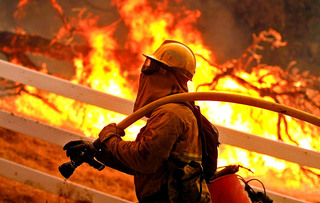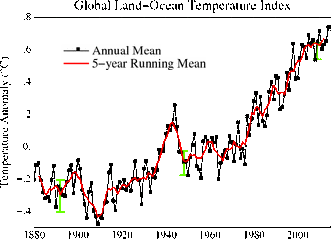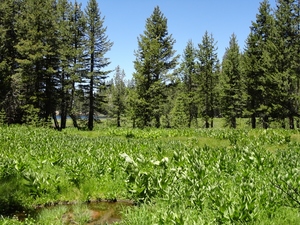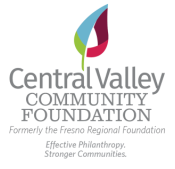"One Watershed" Series
|
#5 Climate Impacts on Drought and Fire: Watershed Solutions Needed
September 1, 2015

We don’t know what El Niño will bring. But we do know that we’re in a fourth year of devastating drought, that unprecedented fires are consuming the western United States, and that land is sinking in at rates faster than we’ve ever seen as a result of increased groundwater pumping.
And as of recent research, we can also feel pretty confident that climate change is intensifying the drought and its outcomes. Global warming, caused by human activity, has most likely intensified the drought in California by 15 to 20 percent says a recent study. Scientists warn that future droughts are almost certain to get worse. Temperatures around the globe are rising. In California, the average has climbed nearly 2 degrees Fahrenheit since 1895, which is significant. “It really is quite simple,” said Richard Seager, senior climate scientist and a co-author on the new study. “When the atmosphere is as warm as it is, the air is capable of holding far more water. So more of the precipitation that falls on the ground is evaporated, and less is in the soil, and less gets into streams.” A warming climate also affects how we receive precipitation. Climate change models point to more rainfall and less snowfall. The Sierra Nevada snowpack, which serves as the state’s single largest reservoir, accounts for about 60% of the state’s developed water supply. In spring months, melted snow flows downstream to fulfill water needs throughout the hotter months. Less snowpack results in earlier and less abundant run-off. Climate change, in other words, is creating new water challenges and needs. “The whole water system that we have in California was designed for the old climate,” said Noah S. Diffenbaugh, Stanford climate scientist.  Image source: NASA (http://data.giss.nasa.gov/gistemp/graphs_v3/) Image source: NASA (http://data.giss.nasa.gov/gistemp/graphs_v3/)
Another side effect of drought is that hydropower, which relies on water releases from reservoirs, decreases – it’s at its lowers level since 1977. Hydropower is a renewable energy that reduces our dependence upon the fossil fuels causing climate change.
Fires are an obvious product of the hotter, drier temperatures we’ve been seeing. Parched soils and insect infestations are a double whammy for trees, which are dying off at a rapid pace, turning our forests into a tinder box. These fires impact public safety, public and private infrastructure, water supply, air quality, and wildlife. Exceptionally large, hot fires like the 2013 Rim Fire in and near Yosemite National Park endanger the recovery of forest ecosystems. “Our low forested areas are changing rapidly. You can actually see climate change happening when drive up to Sequoia or Kings Canyon,” said Dick Moss, Vice President, Provost and Pritchard Consultants. While much of the climate adaptation research aims to prepare Californians (and other regions around the world) for more frequent and longer warm-dry spells, research indicates we must also prepare for more intense storms and erratic weather patterns due to increasing temperatures and moisture in the atmosphere. Most of us in the Western United States are crossing our fingers for a good El Nino. But a “good” El Niño might not turn out to be such a good thing. If forecasters are correct about an impending "Godzilla El Niño," then it’s too late to prepare for the onslaught of floods that may or may not end the drought. If, indeed, El Niño drenches California, there’s considerable evidence that the warm storm could bring abundant rain, but little snow to feed the parched Sierra Nevada reservoir, so critical to meeting our annual water demand.  Healthy meadow in Yosemite National Park. Healthy meadow in Yosemite National Park.
The truth is, we don’t know. Our only certainty is uncertainty. While no one wants to prepare for an uncertain disaster, we have an opportunity here. Unlike an earthquake or hurricane, we have the tools and knowledge to avert disaster.
The solution is to adapt to the new and changing climate. “If we don’t prepare now, we’ll suffer more later, and the cost of taking action now is much less than inaction will cost in the long run, according to economic analyses,” said Michelle Selmon, climate change specialist for the Department of Water Resources. Watershed planning and collaboration has proven successful in other regions of the United States. It has an end goal to rebuild nature’s resiliency and to strengthen the ability of our mountain meadows, forests, rivers, soils, and air to perform the natural services they provide. Humans depend on the services nature provides such as clean water, erosion protection, flood protection, fire protection, pollution filtration, carbon capture, and diverse ecosystems that naturally create balance. Humans have flourished since the last Ice Age, yet our activities have imperiled the natural systems that gave rise to our modern cities and farms. Restoring those systems is paramount to future sustainability in the face of climate change and requires significant planning and public investment. The White House recently created the Resilient Lands and Waters Initiative. This initiative will facilitate greater cooperation and investment in landscape-scale projects that advance conservation and restoration to build resilience in vulnerable regions, enhance carbon storage capacity, and support watershed-level resource management. The California headwaters is one of three geographic focal areas, drawing attention to the dire need for watershed-level planning here and the potential to promote and spread success elsewhere around the globe. Michelle Selmon and the Tulare Basin Watershed Workgroup are eager to add value to the project, ensuring that the Tulare Basin Watershed maximizes its potential for resilience. “While the challenge is daunting, we have successes to model after,” said Selmon. “And we have great organizations and agencies working toward the same goals. Solutions are within reach if we can build broad-based support and momentum.” There are also individual actions that we can all adopt into our lifestyle to mitigate climate change: use energy-efficient lighting, compost and recycle, heat and cool our homes more smartly, use less water, reduce the miles we drive (carpool, bike, take public transit, drive less), invest in solar, learn more and become an advocate for positive change. Learning about climate change and talking about the issue with family, friends, and peers is very important too. If we can take action to alter the trends that created this spike in climate chaos, then why wouldn’t we do it? -- Resources: 1. https://mitpress.mit.edu/books/why-are-we-waiting 2. http://climate.nasa.gov/ 3. http://www.nytimes.com/2015/08/21/science/climate-change-intensifies-california-drought-scientists-say.html?hp&action=click&pg&module=first-column-region®ion=top-news&WT.nav=top-news&_r=2 Authored by Niki Woodard, Communications Specialist for the Tulare Basin Wildlife Partners, who has been working with various land conservation and watershed health initiatives in the San Joaquin Valley for the past seven years. Niki also works for the Center for Climate Protection.
|
Mission: To raise awareness about the Tulare Lake Watershed and its unique attributes, challenges, and opportunities. From the snowy peaks to the valley floor, we are one watershed.
This project is made possible by grant funding from the Central Valley Community Foundation, formerly the Fresno Regional Foundation.
This project is part of the Tulare Basin Watershed Initiative.
HELPFUL LINKS:
|




